Diabetes Mellitus
What is diabetes?
Diabetes mellitus (sugar diabetes) is a disorder caused either by insufficient production of the hormone insulin by the pancreas, or by inadequate response of the body’s cells to insulin. Because diabetic animals are unable to utilize glucose properly, they develop hyperglycemia (high blood sugar) and subsequently glucosuria (sugar in the urine). Diabetes id diagnosed by laboratory determination of hyperglycemia and glucosuria.
Some common signs of diabetes are excessive thirst, excessive urination, and weight loss, (in spite of maintaining a good appetite). Progression of the disease may lead to loss of appetite, vomiting, dehydration, and weakness. Dogs may develop cataracts and eventually blindness.
Treatment
The severity of the disorder determined the protocol treatment. Adequate control of most diabetic dogs and cats requires insulin injections to be given once or twice daily as well as providing a controlled diet. Animals that are seriously ill at the time of diagnosis may require hospitalization.
The most important aspect of treatment is owner commitment. This is a disease that we do not cure, but manage (with the exception of diabetes caused by medications and other disease, which may sometimes resolve if these factors are removed). Long - term treatment usually requires 12 hourly insulin injections and feeding, which cannot be missed. Regular monitoring is also important to make sure the patient is not getting too much or too little insulin. Therefore, there are ongoing costs (medications, blood tests, equipment +/- special diets) plus a significant time commitment. It is often useful to establish whether you will be able to organize another carer who is prepared to give injections in case you need to go away.
The mainstay of treatment is insulin, given twice daily as an injection under the skin, usually at the same time as meals. If the patient does not eat, then a reduced amount of insulin is usually given (usually ¼ - 1/2 dose) and if this continues, veterinary advice must be sought. There are a number of types of insulin used, and the choice is usually up to the prescribing vet. It is most important to make sure that the insulin is stored properly (usually refrigerated). Before use it usually needs to be mixed gently then drawn up into the syringe. The injection can be given in a number of places, including the scruff of the neck or the side of the chest. The skin is tented to form a triangle and the needle placed gently into the center of the triangle to make sure it is given into the subcutaneous tissue. Sometimes it is hard to tell if you have got it in as you are usually administering small amounts and there is lots of fur. If you are having trouble, ask your vet to clip a small square of fur so you can see the skin.
Diet is another important factor in management of diabetes. There is a lot of debate about the type of diet that best facilitates good diabetic management. The most important thing is making sure your dog eats two equal meals morning and night, at the same time as insulin administration. The diet should ideally be a good quality commercial diet. Home - prepared meals are also an option but these must be discussed with your veterinarian so we can ensure that the diet meets your dog’s energy and nutritional requirements.
Regular exercise is also important. It will help achieve or maintain a healthy weight and better glycemic control. Excessive exercise however is probably not ideal.
Care and Administration of Insulin
*Keep insulin refrigerated except when in use. Store in a cooler when traveling. *Use insulin syringes that are appropriate size for the amount of insulin being given (1/3-1/2cc for small doses of less than 20 units.) *to mix insulin, gently roll vial in the palms of your hands. DO NOT shake vigorously. *Insert needle into the vial while mixed vial is held inverted. Withdraw the insulin into the syringe until the volume greater than the actual dose is aspirated into the syringe. Depress the plunger to expel any bubbles or excess insulin back into the vial until the proper dose remains in the syringe. It may be necessary to give the syringe a “gentle tap” to allow large bubbles to rise to the top prior to expelling. It is not essential to evacuate every tiny bubble, particularly if the dose is greater than 10 units.
Monitoring Your Pet
Give your pet time to adjust to the presence of insulin or to any changes in type or dose of insulin. It is not uncommon to treat for weeks before noticeable decrease in thirst and urination is noticed. Glucose in the urine can be monitored using urine dipsticks, but should only be used for an overall assessment of diabetic control. Urine testing should not be used to adjust daily insulin dosages. The best way to monitor your pet at home is to be aware of changes in the frequency and volume of drinking and urination. Changes in weight can also signal the degree of diabetic regulation.
If you notice weakness, lethargy, mental dullness, sudden inappetence or seizure after your pet begins insulin therapy, call your veterinarian immediately. Usually blood glucose is low in this situation. Administer sugar in the form of corn syrup or maple syrup on the gums then seek medical attention for your pet.
Your veterinarian may have you schedule regular glucose curves as needed. During the glucose curve, your pet spends the day in the hospital receiving serial blood glucose determinations. We ask that you bring your pet’s current diet, insulin and syringes so that the glucose curve will more closely reflect a normal day for your pet. Do not feed or give your pet insulin on the morning of the test. The insulin will be administered after the first morning blood glucose is determined. These serial glucose curves are especially helpful when determining your pet’s initial dose and frequency requirements for insulin. They may also be scheduled at other times if changes in insulin needs are suspected. Another test called a fructosamine test may also be used to monitor your pet’s response to insulin. Your veterinarian will determine which test is the best method to monitor your pet.
Other considerations
Diabetes mellitus may predispose your pet to other complications. Careful observations of your pet will be essential to pick up other changes that may be associated with diabetes. Diabetic animals are more susceptible to secondary infections especially of the urinary tract. This may result in your pet urinating more frequently or in inappropriate locations. Complications of therapy can occur, particularly the development of diabetic cataracts, which can lead to blindness. These can be removed, which usually leads to a return of vision, as long as the retinas (back of the eye) are not affected by the diabetes. Another complication is the risk of hypoglycemia due to an insulin overdose (usually either due to too large a dose or not enough food intake). This can lead to seizures, weakness, shaking and disorientation. If this occurs and your dog is conscious and able to eat, feeding a meal may help. If they are unable to eat, glucose syrup or honey can be placed in the mouth and veterinary care should be sought immediately. An infrequent disorder called diabetic neuropathy may cause cats to become progressively weaker in the rear legs. A dangerous condition called ketoacidosis may develop in cats or dogs and includes vomiting, diarrhea, lethargy, dehydration, and breathing abnormalities. Ketoacidosis require immediate medical attention. Please notify your veterinarian if any of these changes occur in your pet.
Monitoring glucose and ketones in your pet's urine
Immediately following diagnosis, your veterinarian may ask you to check your pet's urine glucose, 1 to 3 times a day:
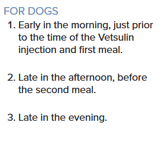
As your pet's management progresses, less frequent testing will be needed. Regular examinations remain important though, because your pet's insulin needs can change.
What you need
- Clean containers for collecting urine.
- Urine dipsticks from your veterinarian.
- A place to record results.
Collecting urine
- For dogs: take your dog out for a walk on a leash. Keep your dog on a leash so that it will be within reach when it urinates. For cats: place your cat in its litter box.*
- Have a clean, dry container (dish, bowl, or small pan) ready to catch urine when your dog urinates.
- When your dog begins to urinate, slowly slide the container under the urine stream.
*Urine collection can be facilitated by using special cat litter, such as hydrophobic sand. Kit4Cat is one brand that can be top coated to your regular litter.
Using urine dipsticks

Follow the instructions for the dipsticks you're using, particularly for the time to read the results.

Place the dipstick in the container with the urine and soak the test pads.

Remove the dipstick and tap dry.

Read the result after the time specified on the stick bottle (usually 1 minute).

Hold the stick against the chart on the dipstick container to compare colors.

Record the results including time of collection and time of insulin injections given on that day.
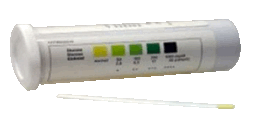
Collecting and testing a blood sample
Using a glucose monitor
A drop of blood is placed on one of the provided strips; the strip is then inserted into the glucose meter, and the blood glucose concentration is shown. Read the instructions provided before use.
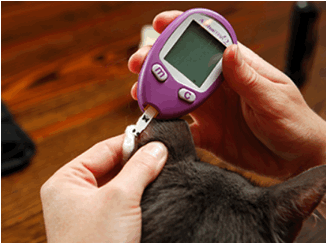
A glucose meter and glucose test strip are needed for this procedure. Blood can be collected easily from the earflap (pinna) of your dog.

Make sure that your dog’s ear is warm. If not, hold it between your hands for about 1 minute. Warming the earflap makes collecting a drop of blood easier.

Quickly prick a clean, hairless part of the ear with a sterile hypodermic needle or lancet.

A small drop of blood will appear. Collect the drop onto the glucose test strip.

Gently but firmly press some clean cotton or gauze onto your pet's ear until it stops bleeding.

Read the test strip or insert the sample into the glucose meter as instructed. Compare the reading to the normal level in dogs or cats.
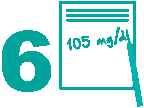
Keep a record of the readings to share with your veterinarian.

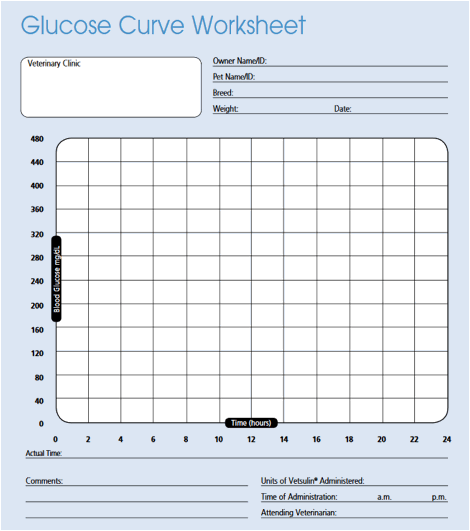
List of suggested monitoring devices:
AlphaTRAK 2 Veterinary Blood Glucose Monitoring Starter Kit
Petlet Blood Glucose Meter Kit - Calibrated for Dogs